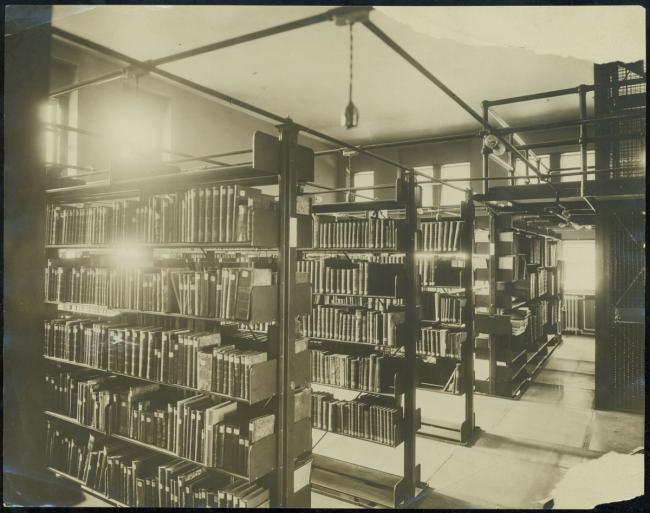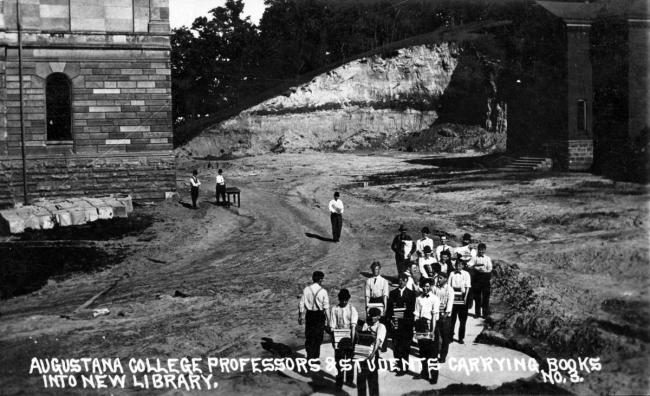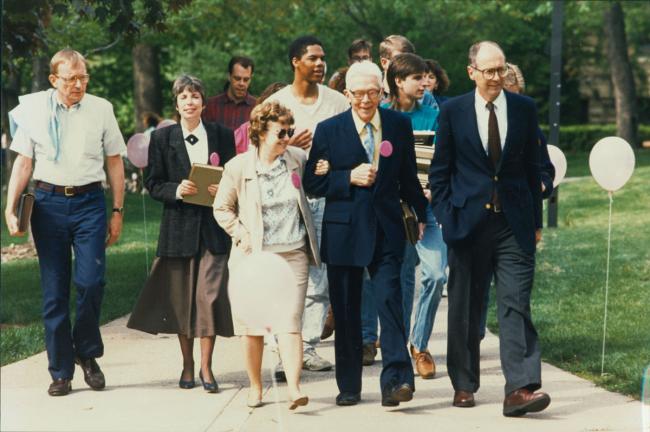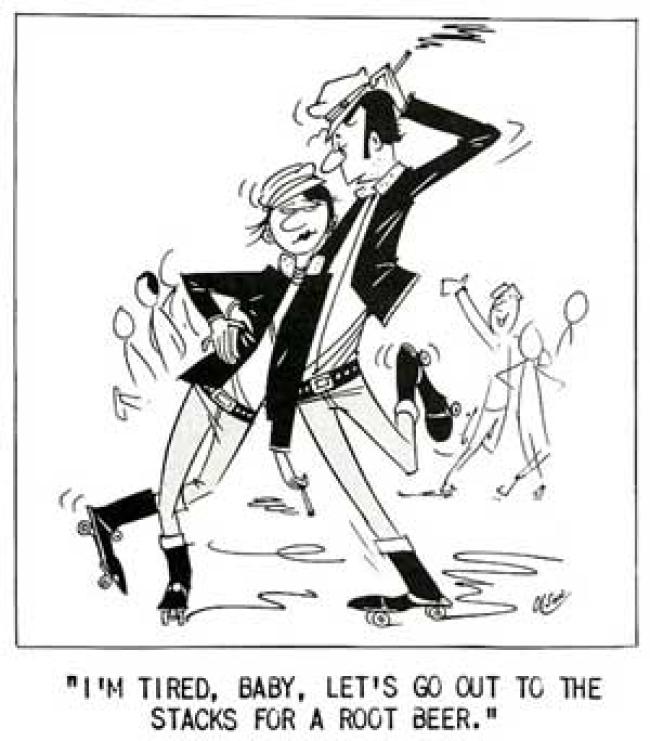The Augustana Library: A noisy history
(This story was written in celebration of Augustana's sequicentennial in 2010.)
Picture an elegant reading room with dim lighting and lots of dark woodwork. A gray-haired woman sits at a large desk, glasses perched on her nose, disapproving look on her face.

You probably can guess where we are and what is going to happen. Whispering and shushing escalate to loud talking and fruitless threats. Soon people are laughing, shouting, even singing and dancing. The crotchety woman is defeated and banished — or, on rare occasions, she joins in the noisy fun. This is a library!
That’s the television and movie version. In real life, students need to study and write papers. In 2006, a disgruntled Augustana student wrote to the Observer, mourning the change since his high school days, when it was “pounded into our undeveloped brains that…we not speak in the library.”
A library should not have “quiet floors,” he wrote, but should be a “quiet building” in which the librarians (and, presumably, everyone else as well) should “lower their voices to a whisper.”
Two weeks later, the library director — yours truly — wrote a guest column discussing the ways in which today’s “vibrant” undergraduate libraries differ from yesteryear’s “austere places where strict rules applied to all behavior.” Oh, how wrong I was!
The college catalogs of 1881 through 1887 — which in those days, served as both catalogs of courses and annual reports of the college — contained yearly complaints of inadequate library space. So it was with great joy that librarian C.L.E. Esbjorn announced the library’s move to its “commodious new quarters” on the third floor of “Memorial Hall” (now known as Old Main) in 1888-1889.

The library contained 13,000 volumes and subscribed to 60 periodicals, including English, Swedish, French, and German magazines, Swedish-American weeklies, and Chicago dailies. The library also served as the college’s museum. It seems that the library was open all day for study, but hours for checking out books were very limited (just six hours each week in 1890). There were no reports of noise in the reading room, but one would hardly expect to find those in an official college publication.
Only a few years passed before the library’s quarters no longer seemed so “commodious.” Then in February 1909, the Observer reported that the sons and daughters of the late Mr. and Mrs. F.C.A. Denkmann had given Augustana funds for “a library to cost not less than $100,000.” President Gustav Andreen made the announcement to the campus on Jan. 28, noting that it was the largest single gift that the college had received to date. That evening, as noted in a previous week’s story, in a heavy winter rainstorm, several hundred Augustana students walked three miles through Rock Island to serenade the home of each donor.
The library was dedicated on May 1, 1911. In October 1911 student Sigfrid Blomgren reports that “the new library, with its magnificent reading room is now fully in use” and that “the making of a complete catalogue, giving author, title, and contents is now under way.”
Unofficial reports
With the publication of the student newspaper, beginning in 1902, we move beyond the official information and comments about library space included in the old college catalogs. All is not peaceful in that beautiful new library. The first page of the March 1, 1919, Observer features a full-page editorial on the escalating struggle between library staff and students concerning appropriate behavior in the reading room.

Apparently a zero-tolerance “No Talking” policy in the reading room had suddenly replaced a more laissez faire approach, and some form of strict discipline — sadly not described in the piece — was applied. This gave rise to student backlash that included full evenings of “scraping chairs, whistling, and laughing.”
“We fondly imagine that in doing these things, we are hurting the Library force, while in fact we are simply spiting ourselves,” the editor writes, pointing out that the head librarian has realized his mistake and has become more lenient. “It will be our purpose in the future to give one page in each issue of the OBSERVER to the publication of interesting library news,” the writer says, presumably doing his part to improve the student-librarian relationship.
But the outcry over library noise wasn’t over. In January 1957 reporter Max Kirkeberg wrote a long piece entitled “The Decline And Fall Of The Augustana Library.” The story recounts the takeover of the library by a very large student group and its conversion to a new student union. Radios and typewriters are brought into the reading room and all but 253 books are removed because the others pose a “menace to health and safety” during freshman roller skating in the stacks. In the same issue, a short article notes that “The Decline…” is a satire, and that in reality, the library has become quieter due to cooperation between the library staff and a student committee.
“Many students have expressed their appreciation that this year it is possible to study in the reading room,” says head librarian Dr. Lucien White.
Modern noise
The calm was short-lived. In May 1964 “a disgusted student” wrote to the editor, stating that “the noise in the Augustana Library is unbelievable. In the reading room… students talk constantly.” They “don’t have the courtesy to whisper — they talk aloud.” The current library, opened in 1990, provided much more space and no formal reading room, both of which may have temporarily alleviated the problem.

But by the year 2000, the only recurring complaint received by the staff of the Thomas Tredway Library was (and is) “noise.” Now able to search the digitized Observer, I discovered that “noise in the library” is a time-honored — or time-abhorred — tradition. (Since I had seen "The Music Man," with its frolicking library users, set circa 1910, I guess I should have known!)
Of course, modern research has shown us that students learn not simply through individual, quiet study, but during discussions, presentations, and group projects as well. Much of the “noise” in today’s libraries occurs for good reason and deserves to be supported.
But there is still the undeniable tendency for such interactions to turn into good old socializing and hilarity. Perhaps a 1915 graduate’s reminiscence of his years at Augustana, written in April 1920, captures it best.
He recalls an elderly, emeritus professor who presided over the library by “snoozing peacefully as a child, while in the reading room turmoil ruled. His successor, Prof. S., tried hard to have the students themselves decide to abstain from using the room as a club, but his and, I understand, consequent efforts have been in vain. Old Dr. G. never troubled himself with such reform — perhaps he had learned in his long life something of human nature.”
— Carla Tracy
Library Director
